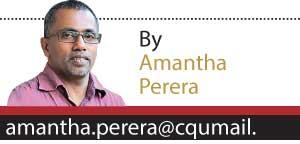27 Jul 2022 - {{hitsCtrl.values.hits}}

During the July 22 crackdown by the government on the protesters, some journalists including foreign correspondents have been injured and hospitalised
Being a journalist in Sri Lanka historically is a terrible career choice. Not only are you chronically paid miserably low, but there is the constant threat of assault, abuse and even the occasional murder. Career stability is measured in months, sometimes days. And this is when times are normal.
miserably low, but there is the constant threat of assault, abuse and even the occasional murder. Career stability is measured in months, sometimes days. And this is when times are normal.
In the current circumstances, the operating conditions are all of the above into the power of three or four.
That begs the question, why do we become storytellers? This has been a perennial question posed at me. It is one that many journalists working in Sri Lanka ask themselves repeatedly these days.
"Most of the journalists who have been reporting on the current crisis say that they have very little space within their work communities to talk of the interlock between work and life stressors. Their biggest fear is the risk of appearing, even in the slightest way, weak and vulnerable"
One of my colleagues recently spoke of reporting the protests, the queues and misery all around without a break. Then going home every day to relive that misery in the most intimate of circles. There is no let up from the cycle of tragedy -- physical or emotional.
She spoke of lack of gratitude from the general public. Instead, their anger is frequently directed at the messengers. She told me how terrible a load it was to carry all this and have no space to talk of it.
Part of my work with the Dart Centre for Journalism and Trauma has been to work on creating safe workspace for journalists in the region. Right now, Sri Lanka is one of our number one priorities. The journalism community here is facing multiple challenges and there is very little by way of outside help or in-country resources.
"Part of my work with the Dart Centre for Journalism and Trauma has been to work on creating safe workspace for journalists in the region. Right now, Sri Lanka is one of our number one priorities. The journalism community here is facing multiple challenges and there is very little by way of outside help or in-country resources"
Despite the presence of a large contingent of foreign journalists and massive international interest on Sri Lanka, that will not translate to lifting the working conditions of Sri Lankan journalists. My Sri Lankan colleagues are filling an unusually increased demand in a fickle supply chain. Even doing that they feel overwhelmed and besieged. The current wave of social unrest was preceded by the pandemic. Since 2020 it has been on a treadmill of intensity.
Sri Lankan newsrooms have historically been not conducive to the trauma dialogue. Years of war reporting has intensified the false ideal of the bulletproof journalist. Most of the journalists who have been reporting on the current crisis say that they have very little space within their work communities to talk of the interlock between work and life stressors. Their biggest fear is the risk of appearing, even in the slightest way, weak and vulnerable.
Social media has given some vent to these frustrations. Dozens of journalists who have reported on the Aragalaya, now not only identify with it, but have been active personalities in it. It is the positive bias that is taking effect. It is, still, a bias that clouds and undermines the role of the independent storyteller. A bias that can also endanger workplace safety.
"Social media has given some vent to these frustrations. Dozens of journalists who have reported on the Aragalaya, now not only identify with it, but have been active personalities in it. It is the positive bias that is taking effect"
There is increased focus on the mental wellbeing of journalists and its impact on freedom of expression. This is partly due to what the world experienced in the last two and-a-half years. But that dialogue has been a slow starter in Sri Lanka, especially inside newsrooms still unable to breakout of the war reporting template.
Part of my current research explores the impact of the performative nature of social media on journalism. One thing that is quite clear is how many colleagues in Sri Lanka are using social media without the application of strict journalistic norms and best practices. Opinions and biases seep in freely when these self-imposed trap doors are not effective.
What we need to be mindful is that opinion and bias can cloud the news arch and create echo chambers as easily as fakes and misinformation.
Time to decide whether your Twitter feed is part of your professional journalism or just an avenue for tearoom chat. That tearoom however is an extremely large one.
The writer is a journalism researcher and a writer. He can be contacted on
27 Nov 2024 15 minute ago
27 Nov 2024 2 hours ago
27 Nov 2024 2 hours ago
27 Nov 2024 2 hours ago
27 Nov 2024 3 hours ago